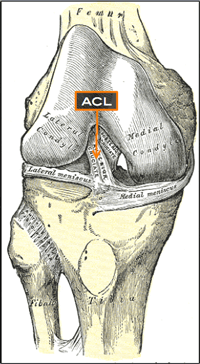Anterior Cruciate Ligament (ACL) Injury
What is the anterior cruciate ligament?

Illustration of a right knee showing the relationship of the ACL to the surrounding knee structures. As shown here, the ACL runs from the lateral femoral condyle to the anterior aspect of the tibial plateau, where it inserts between the medial and lateral meniscus.
The anterior cruciate ligament (ACL) is an important stabilizing structure in the knee. It is located in the center of the knee and runs obliquely from the femur to the tibia (see figure). The ACL functions to maintain rotational and translational knee stability during athletic activity.
What causes an ACL injury?
ACL injury most often occurs during a non-contact athletic maneuver such as cutting, pivoting, or landing from a jump. ACL tears are more likely to occur in female athletes than males. ACL injuries occur commonly in sports such as soccer and football.
What are the symptoms of an ACL tear?
Individuals with ACL injuries often report feeling or hearing a “pop” and feeling a giving way sensation in the knee during a non-contact cutting or pivoting injury. The knee typically swells significantly shortly after the injury. After the swelling subsides, the knee may feel unstable. Meniscus tears occur in about half of patients with ACL injuries and may result in clicking or pinching sensations felt within the knee.
How is an ACL tear diagnosed?
Dr. Driscoll will discuss your symptoms with you and perform a thorough physical examination of your knee. X-Rays are usually obtained to rule out bone problems. If Dr. Driscoll suspects that you may have an ACL tear or other soft tissue injury, an MRI is usually recommended. The MRI generates excellent images of the soft tissue structures around the knee, including the ACL, and is usually sufficient to confirm the diagnosis.
What is the treatment for ACL tear?
Treatment options include non-surgical and surgical alternatives. Non-surgical treatments include physical therapy, bracing, and activity modification. When surgery is selected, arthroscopic ACL reconstruction is the treatment of choice. The best treatment depends on your age, activity level, and associated injuries. You and Dr. Driscoll will discuss your individual situation and create a treatment plan tailored for you.
